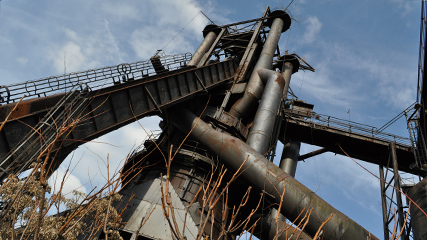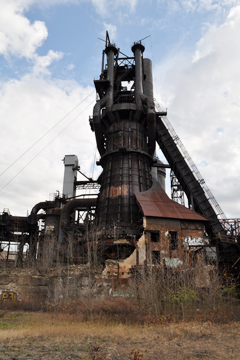
Blast From the Past: Old Steel Mill Forges New Life as a Park
Ben Muessig
AOL News
(Dec. 2) — Preservationists outside Pittsburgh are fighting to put an abandoned steel mill back to work — not so it can produce metal, but so it can protect history.
Since the blast furnaces fired up for the last time at the Carrie Furnace in 1978, the decaying steel mill on the bank of the Monongahela River has served as a solemn reminder of the industry that turned Pittsburgh into a thriving city — then left it polluted and jobless.
Now, more than three decades after the Carrie Furnace went from being a bustling workplace for 4,000 employees to a 168-acre ghost town, a team of preservationists is trying to convert the remains of the hulking factory in Rankin, Pa., into a museum dedicated to the region’s steel history.
“Pittsburgh is known for steel,” said Sherris Moreira, a spokeswoman for Rivers of Steel Heritage Corp., the group spearheading the preservation project. “There is this pride that people here have for their steel heritage — and this is a tangible way for people to connect with that history.”
Rivers of Steel hopes to preserve the remaining structures, transforming the industrial ruin into an interactive historical center inside a park.
At the heart of the proposed preservation project are the two remaining blast furnaces, which were built in 1907 and left largely unchanged until U.S. Steel halted operations at the Carrie Furnace.
The massive ovens are rare examples of pre-World War II steel-making technology — and they could make the perfect centerpiece for the proposed museum, according to Rivers of Steel curator of collections Tiffani Emig.
“They were never invested in for improvements and they were never upgraded. Everything was done by hand up until the day it closed,” Emig said. “That’s what makes them special.”
Those industrial relics — along with five other furnaces that were demolished — manufactured as much as 1,200 tons of iron per day, creating metals used in the construction of the Empire State Building and St. Louis’ Gateway Arch.
When the blast furnaces were operational, they turned ore, coke and limestone flux into a molten metal that was transported by rail across the aptly named “Hot Metal Bridge” to U.S. Steel’s Homestead Works, where it was converted into steel.
The Homestead Works were razed in 1988 and the site was converted into a shopping mall in 1999. Today, all that remains of the historic steel mill are the smokestacks, which tower over a movie theater parking lot across the river from the Carrie Furnace.
The Carrie Furnace has already been deemed a National Historic Landmark, meaning it likely won’t meet the same fate as the Homestead Works. But that doesn’t mean the site isn’t in danger.
When industry moved out, nature moved in. Tree roots have undermined the stability of some Carrie Furnace buildings, and grapevines scale the superstructure of the sprawling mill. Foxes, hawks and deer have recently been spotted on the site — and they’re not the only new visitors.

Since U.S. Steel halted operations at the Carrie Furnace in 1978, nature moved in. Trees tangle their way through the plant, and grapevines crisscross the catwalks. Ben Muessig for AOL News
The abandoned steel mill has become a destination for graffiti artists, paintball players, vagrants and vandals who strip the site and sell the stolen scrap metal.
“The wiring and anything else that can be scrapped has been taken out,” said Emig, who told AOL News she’s often chased away uninvited visitors. “With the graffiti, the paint wears off. It’s the people who are physically stripping the site who are the problem.”
Rivers of Steel plans to restore some parts of the Carrie Furnace to look the way they did when the plant was operational. But other parts — like a massive sculpture of a deer head built from metal and wire in the 1990s by the Industrial Arts Co-Op — will remain as they are today.
“We will preserve some of the graffiti, definitely the deer,” Emig said. “This site didn’t die in 1978. This place continued to be used, and we want to show that.”
Even if Rivers of Steel gets its wish and is able to preserve the remaining steel mill structures, the rest of the 168-acre property could look very different in the coming years. Allegheny County owns the entire site and began renting the Carrie Furnace buildings to Rivers of Steel in May.
County officials are looking for builders interested in bringing light manufacturing and residential development to the rest of the grassy plot.
New businesses or homes near the old steel mill will certainly change the site’s context, but they won’t compromise the Carrie Furnace as a historic site, according to Emig.
“It’s already compromised,” she said. “There’s only two furnaces left; there used to be seven. You work with what you have.”
The most important thing the Carrie Furnace has is its historic site, according to Arthur Ziegler, president of the Pittsburgh History and Landmarks Foundation.
“We have saved artifacts from the mills — blowing engines, a Bessemer converter and so forth — but we had to relocate them,” Ziegler said. “But this will be the first time it’s all preserved on site.”
Obviously, making the dilapidated steel mill a safe destination for sightseers isn’t going to be easy — or cheap.

Turning the decaying steel mill into a park and history center won't be cheap -- but preservationists say residents of the "Steel City" are rallying behind their plan. Ben Muessig for AOL News
The group’s “bare-bones cost estimate” for the project is $78 million. Current funding only allows for repairs of a severely damaged roof at one of the powerhouses.
To fund other projects, like securing shaky catwalks, clearing out tons of debris from the mill’s stock house, or perhaps building a monorail like the one depicted in flashy conceptual images of the historic center, the group will seek public funding and private donations.
There’s talk of approaching the National Parks Service for help, but it’s unclear whether the cash-strapped agency would be interested in or able to offer assistance.
Though finances are a concern, Moreira says she’s been encouraged by the interest in the project.
“Heritage matters,” said Moreira, whose group has given tours of the Carrie Furnace to more than 700 eager visitors in the past two months. “It’s not only important to know where we come from, but it’s important looking to the future.”
In the years since the steel industry left Pittsburgh, the “Steel City” has in many ways attempted to distance itself from its metal-producing past. But the city’s industrial legacy lives on — and not just in the name of its football team and local beer.
According to Moreira, many Pittsburghers have started looking to the city’s steel-making roots as a source of pride.
“There was a lot of bitterness when the steel went away. People wanted to move on. But now people are at the point where they want to look back,” she said.
“This isn’t just steel; it’s about emotions.”
